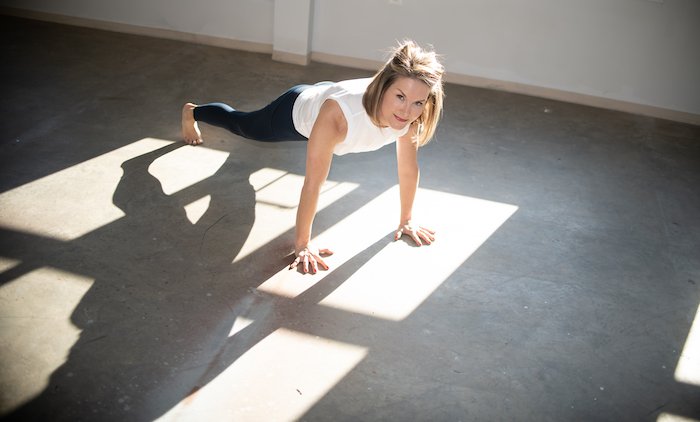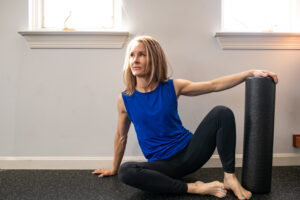You may wonder why you can’t seem to graduate to a “big girl” push-up and why you seem to struggle to hang from a bar for more than 15-seconds or even consider a chin up.
The answer may be a host of reasons, including lack of confidence or strength, yet it can also lie in a part of your body that is used every second of the day – your hands!

You may think the core, hips, or legs are the most important areas of our bodies for effective strength training. Yes, they are large muscle groups and necessary for all full-body movement. You may consider the hands and feet as “supporting actresses” in this game of exercise. Far from it. The hands (and feet) are taken for granted not only as we move (or not!) throughout our days yet could be holding you back from reaching your full wellness potential.
Together the hands and feet form a most perfect duet to help you “feel the movement,” recognize your connection to the ground and utilize the ground to activate the muscles we’re intending to engage.

Let’s take the push-up, the mountain climber, and the bench press as examples of how our hands can make that exercise super effective, or not, simply by utilizing the power of your hands.
Push Up and Mountain Climber
- With proper use of the hands: Using the outside, soft, and fleshy bottom of your hand along with the fingertips in an intentional way is very different than considering them essential to the movement. For example, we practice and coach clients to actively push hands into the floor as if we’re aiming to “press down through the floor.” This action improves the feel of the movement, the amount of muscle tension and activation of the shoulders all the way down to the feet, and ultimately the results of the movement.
- With little use of the hands: Place hands on the floor without much thought and try to get through the exercise as quickly as possible. The likelihood of wrist pain or pressure is great. The ability to feel the shoulders, armpits, lats, core, gluts down-to-the feet is much more limited.
Dumbbell Chest Press
Lis coaches our fitness clients to squeeze the dumbbell at the outside of the palm of the hand.
Because our hands have very sensitive “antennae” for receiving information from the environment they’re touching/pressing/standing, they are a key component of your training program. Therefore, it is important to recognize their position on the ground or the piece of equipment and that each part of them (inside, outside, palm, fingers) plays a role in our exercises and, ultimately, our strength.

For you runners among us…
I’ve been playing with a new hand position to help my gait. It helps my elbows flow straight back instead of “flaring” outside my body. When our elbows “flare” out, the forearms tend to cross over the front of our bodies, which can slow us down and result in an inefficient gait. Instead, we want our forearms to be positioned 90-degrees perpendicular to our body.
I have been aiming for “loose” hands. I softly put my thumb and forefinger together as if I were holding a potato chip. It keeps me focused on my position and even helps me maintain the proper head position. Yep, all from my hands!
The hands – and fingertips – are the key to a phenomenal workout.
- There are 17,000 mechanoreceptors (or touch receptors) in our hands, with the majority in our fingertips.
- The hands are packed with thousands of nerve endings, which produce complex patterns of nervous impulses conveying information about the size, shape, and texture of objects. Our ability to identify objects by touch and manipulate them depends upon the continuous influx of this information.
- The fingers on one hand are bent and stretched about 25 million times over the course of a lifetime.
- There are over 30 muscles and 27 individual bones.
- The skin on our fingertips is particularly sensitive to touch – it is a way to protect the body from harm in the way of heat, dangerous objects, or environments.
Make no mistake: building strength starts with our feet and hands. They are foundational components of proper functional movement.

Here are four reasons your hands should be at the forefront of your mind during every workout:
1. Hands provide support and connection. When we strength train, our hands provide support for our body and are our connection to the ground – the source of connection our body is seeking for resistance and tension. Our hands help us carry daily objects, pull ourselves forward/up, open and close doors, and push ourselves up/away.
2. Our hands help us create tension. A common practice at Alexandria Wellness during exercise with hands on the floor or block is to cue to actively press the outside of the base of the hand and the fingertips into the floor while also actively pulling them toward our hips. This will “pull” the shoulders into our armpits, engage the core (back and front) and start to use a whole host of muscles not naturally believed for use during a push-up or mountain climber. We use every muscle group for a push-up!
3. Hand placement is key. Proper hand placement – evenly placed in line with each other – and on the equipment – helps target the intended muscle groups and determines the amount of tension we will utilize. It also reduces the chance of injury. Changing their placement (wider, narrower, pivoted, inverted, palm up, etc.) can completely change the movement and the muscles we engage.
4. Hands have more “sensory” than any other part of the body. In fact, they take up a larger space in the brain than larger areas like the hips! Connecting with the brain telling it what it’s working is all a part of a complete training program.
We want to help you (and your team!) take charge of your health and wellness. Here are two ways you can get started today. If you are interested in any of our newest programs, like our latest special for our small group fitness program, email us at alicia@alexandriawellness.com.


